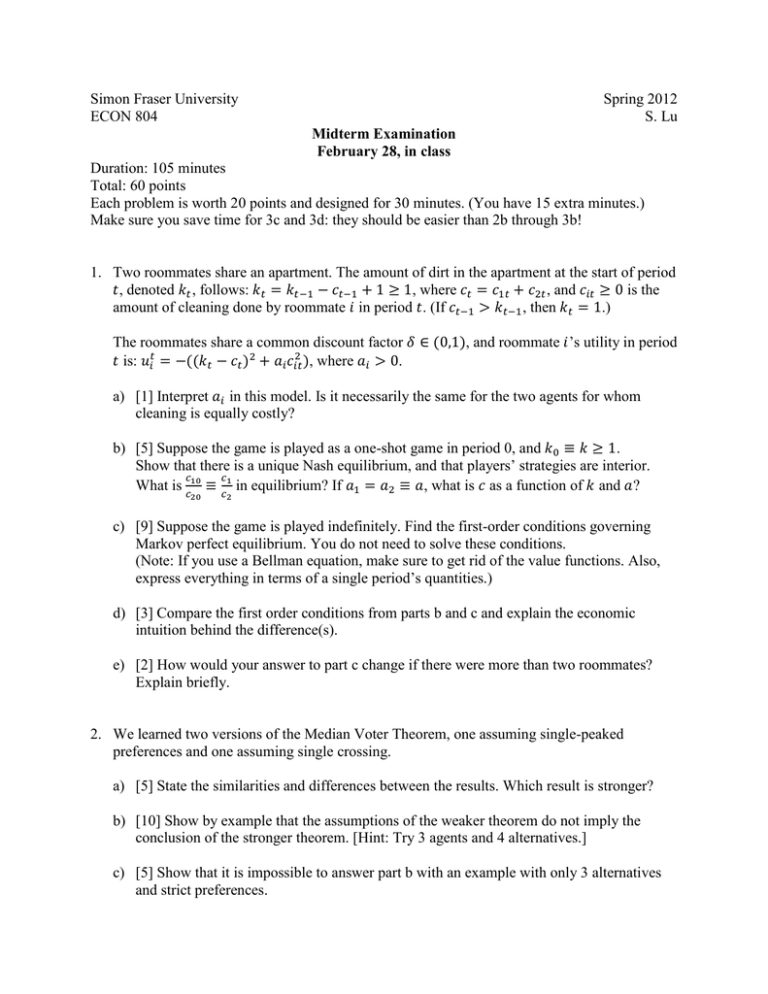Simon Fraser University Spring 2012 ECON 804 S. Lu
advertisement

Simon Fraser University ECON 804 Spring 2012 S. Lu Midterm Examination February 28, in class Duration: 105 minutes Total: 60 points Each problem is worth 20 points and designed for 30 minutes. (You have 15 extra minutes.) Make sure you save time for 3c and 3d: they should be easier than 2b through 3b! 1. Two roommates share an apartment. The amount of dirt in the apartment at the start of period , denoted , follows: , where , and is the amount of cleaning done by roommate in period . (If , then .) The roommates share a common discount factor is: , where . , and roommate ’s utility in period a) [1] Interpret in this model. Is it necessarily the same for the two agents for whom cleaning is equally costly? b) [5] Suppose the game is played as a one-shot game in period 0, and . Show that there is a unique Nash equilibrium, and that players’ strategies are interior. What is in equilibrium? If , what is as a function of and ? c) [9] Suppose the game is played indefinitely. Find the first-order conditions governing Markov perfect equilibrium. You do not need to solve these conditions. (Note: If you use a Bellman equation, make sure to get rid of the value functions. Also, express everything in terms of a single period’s quantities.) d) [3] Compare the first order conditions from parts b and c and explain the economic intuition behind the difference(s). e) [2] How would your answer to part c change if there were more than two roommates? Explain briefly. 2. We learned two versions of the Median Voter Theorem, one assuming single-peaked preferences and one assuming single crossing. a) [5] State the similarities and differences between the results. Which result is stronger? b) [10] Show by example that the assumptions of the weaker theorem do not imply the conclusion of the stronger theorem. [Hint: Try 3 agents and 4 alternatives.] c) [5] Show that it is impossible to answer part b with an example with only 3 alternatives and strict preferences. 3. The United Nations Security Council has 15 seats, with 5 permanent members that each have veto power (on non-procedural matters). Let be the set of all 15 members, and let be the set of permanent members. Nine affirmative votes are required to pass a resolution. Disregarding the possibility of abstention, voting on the Council can be characterized by the following characteristic function game, where is an arbitrary set of countries: a) [4] Find the core of . Show your work. b) [6] Find the Shapley value of . Show your work. No need to simplify. c) [6] Let be the SWF corresponding to the Security Council’s voting rule. May’s theorem requires four axioms (and that there be two alternatives). i. State the one(s), if any, that is/are satisfied by . ii. State the one(s), if any, that is/are violated by . In each case, provide both the name and the statement of the axiom. You do not need to prove your answers, but please briefly justify each. d) [4] Show that each of the four axioms you provided in part d is necessary for May’s theorem. That is, for each of them, give a SWF that violates it but satisfies the three others. Assume that agents can be indifferent between a motion passing and failing (the SWF can have indifferences as well). You do not need to prove your answers.



